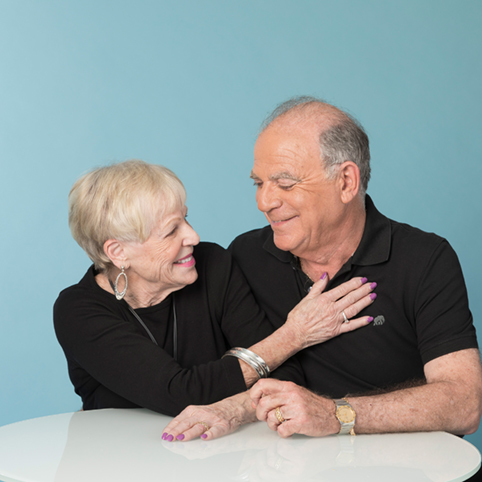
Photo courtesy of Parkinson’s Foundation
The role of a caregiver, sometimes also called a care partner, can be meaningful, but the stress and life changes of caring for someone can also be emotionally draining.
Caregiver burnout occurs when a caregiver feels overwhelmed and begins to remove themselves from their role, leading to the caregiver no longer caring for themself or their mental wellness.
A caregiver experiencing burnout may isolate and lack the energy to care for their loved one. Knowing how to recognize burnout can help you prevent and treat it.
Care Partner Strain
Before burnout comes care partner strain — when a care partner begins to lack empathy for their loved one. The care partner who is affected by emotional exhaustion and frustration begins to lose compassion for their loved one. Strain leads to burnout.
The higher the care partner strain, the lower the quality of care. The care partner and the person being cared for both suffer when the care partner is experiencing strain. A social worker or physician can often help identify care partner strain and give you strategies to help you recover.
If care partner strain starts to progress to burnout, take a minute to identify what you are experiencing. Begin to incorporate a self-care plan if you have not already done so. It is important to consider how you will practice and make time for self-care while also taking care of your loved one.
Signs of Caregiver Burnout
There are multiple ways to measure and identify burnout. It is essential first to recognize you are experiencing burnout because you can then move on to treating it.
Signs of burnout include:
• Fatigue
• Anger
• Withdrawal
• Aches and pains
• Cognitive changes
“I didn’t even realize I was burned out. My daughter told me, and when I asked her why she said I was saying things like, ‘I know I shouldn’t get so frustrated with him right away and I want to change but I don’t know how,’ or ‘I know I’m taking on too much and I need help but I just don’t know what to do.’” – Marlene, Care Partner to her spouse living with Parkinson’s
Prioritize Your Needs
You cannot pour from an empty cup. It is normal to feel stress and guilt when prioritizing your needs as a care partner. You must give yourself time and rest to fill up.
Here are suggestions to help you find the energy to care for yourself:
• Ask family and friends for support
• Go to therapy consistently (not sure where to start? Read this article on tips for finding your ideal mental health counselor)
• Work with a social worker who can recommend resources
• Look into respite care
• Explore in-home care support options
“As soon as he got the diagnosis, we started with a new counselor… We were just newly married for only six months when my husband was diagnosed, so we were still trying to figure out how to become a couple and a blended family. [Our counselor] has helped us through the grieving process of learning about this disease and how to handle it and has made our lives full because we embraced the changes. Yes, we go through down periods as new symptoms come up, but we always seem to focus on all of the things you CAN do.”
– Lori, Caregiver to her spouse living with Parkinson’s
Respite care can be a viable option. It can range from a few hours to longer and can be achieved in a variety of ways. Respite care looks different for everyone depending on financial situations and individual needs. Facilities often offer respite care packages that give you a place for your loved one to stay if you need time for yourself. This is typically private pay and will not be an option for everyone. If finances are tight, consider asking loved ones to chip in towards your “respite fund” for any holiday you celebrate where gifts are exchanged.
You can also explore in-home care support, usually for shorter periods. Bringing in a professional can be a costly option not available for everyone. Sometimes free or low-cost in-home care is available through your local Area Agencies on Aging (search the Eldercare Locator for more information).
If you cannot find affordable or no-cost help, consider whether there is anyone in your life who can step in as a secondary care partner — a family member or a close friend.
Ask for Help
Be honest about your needs; it is okay and healthy to ask for help. Remember that just because you need help does not mean you are failing as a care partner. You do not have to do it all by yourself; caregiving is a team sport. The best way to prevent caregiver burnout is to have a community of support.
Take A Minute
Are you experiencing strain or burnout? If so, say some of your stresses out loud. Next, take a few minutes to think about what simple self-care activity you can implement today, like going for a brisk walk or spending two minutes focused on your breathing.
When you take on the care partner role, you may put the person you care for as the top priority. When all your energy goes to someone else, you may stop caring for yourself. Try shifting your perspective. Caring for someone with Parkinson’s is not the only role you have in life. Tend to your self-care, find what feels safe, and build a community.
Recovering from Burnout
You can always come back from burnout but work towards making adjustments to prevent burnout in the future. These changes may include more time to practice self-care, better communication between you and your loved one, and seeking professional help.
Be intentional about your personal healing. To prevent burnout in the future, find a support community that works for you.
Parkinson’s Caregiver Burnout
Caregiver burnout is common for anyone caring for a loved one, regardless of the disease or stage of life. Since people with PD can have a disease process that progresses over the course of 10, 15, or even 20 years, it is especially important for Parkinson’s care partners to be proactive about preventing and addressing burnout early and throughout their caregiving journey.
According to the Parkinson’s Foundation Parkinson’s Outcomes Project, the largest clinical study of Parkinson’s ever conducted, caregiver burden is associated with faster decline in quality of life with the person with PD. Recognizing caregiver burnout early and addressing it will help you and your loved one with Parkinson’s.
Find Support
The Parkinson’s Foundation works to make life better for everyone whose life is impacted by Parkinson’s, not just those living with the disease. Care partners and loved ones of people with PD are often overlooked, but anyone caring for someone with Parkinson’s knows that PD is a family affair.
To address the needs of care partners, the Parkinson’s Foundation offers a series of self-paced online courses composed of conversations with care partners, lessons from health professionals, self-reflection prompts, and more through the free Care Partner Program: Building a Care Partnership.
One course within the program, “What is Caregiver Burnout?” highlights how Parkinson’s care partners can recognize, prevent and address caregiver burnout. Start this course today to hear from:
- Lance M. Wilson, MSS, LSW, C-SWHC, ASW-G, Neuroscience Medical Social Worker
- Marlene Perdan, care partner to her husband Bill, diagnosed with young-onset Parkinson’s disease 13 years ago, and Parkinson’s Foundation volunteer.
- Lori Russell, caregiver to her husband Bob, diagnosed with young-onset Parkinson’s more than 17 years ago, and Parkinson’s Foundation Aware in Care Ambassador
Sign up for free, self-paced courses designed for caregivers through the Parkinson’s Foundation Care Partner Program today!













